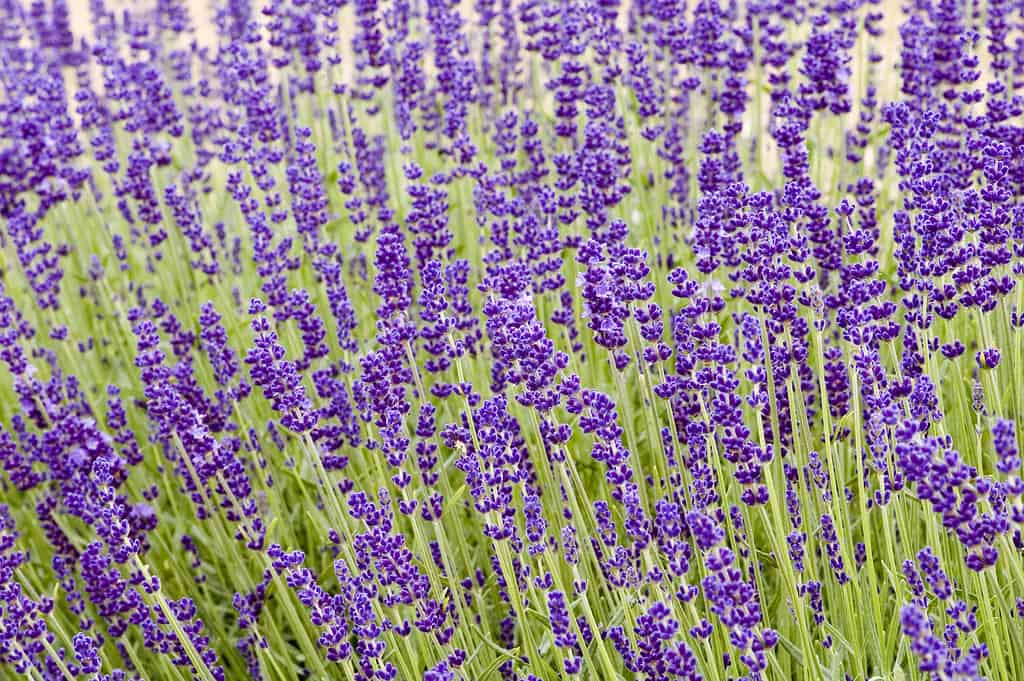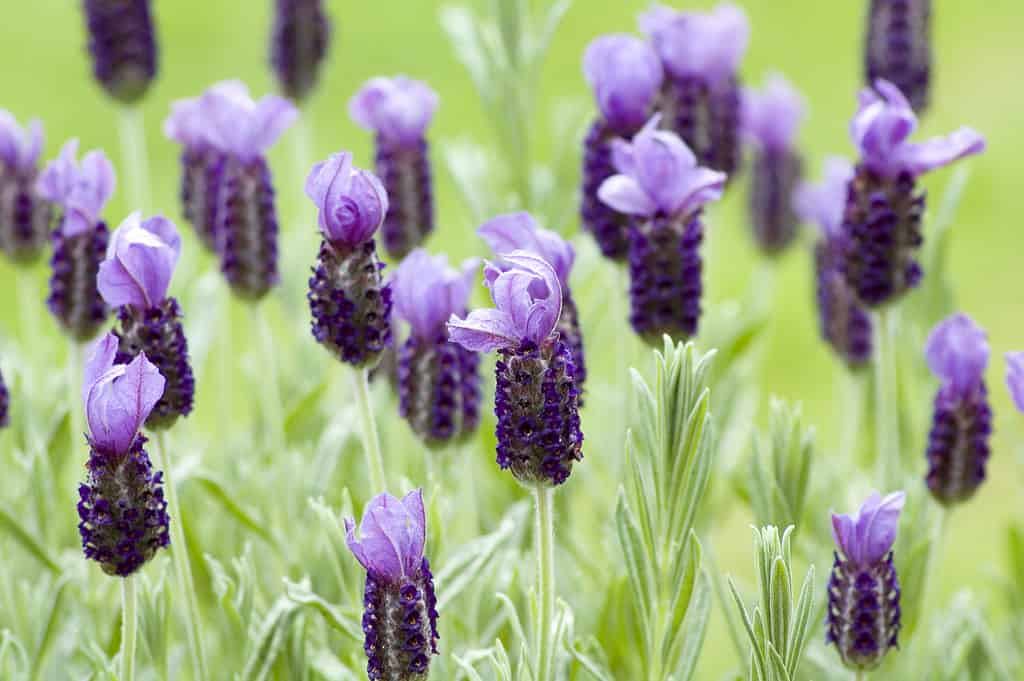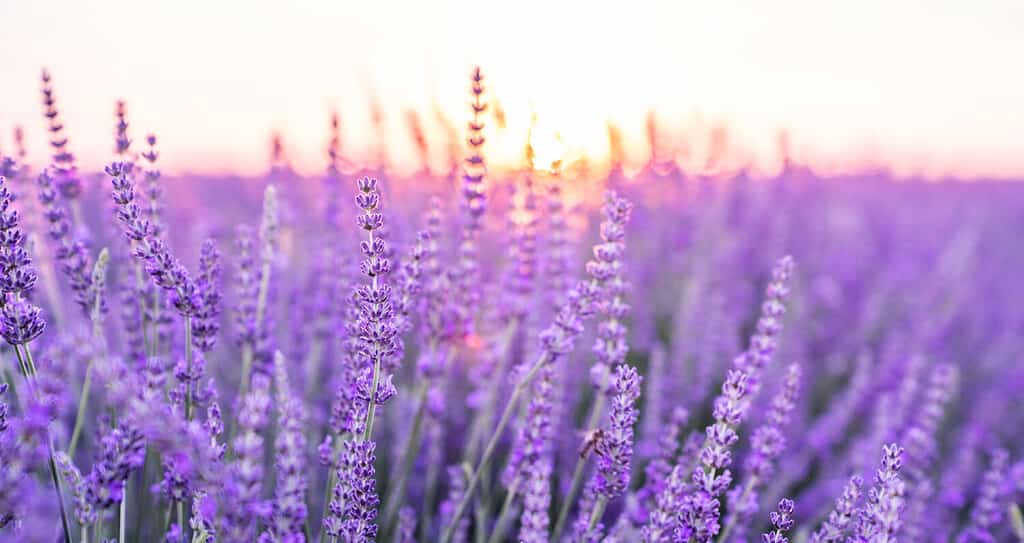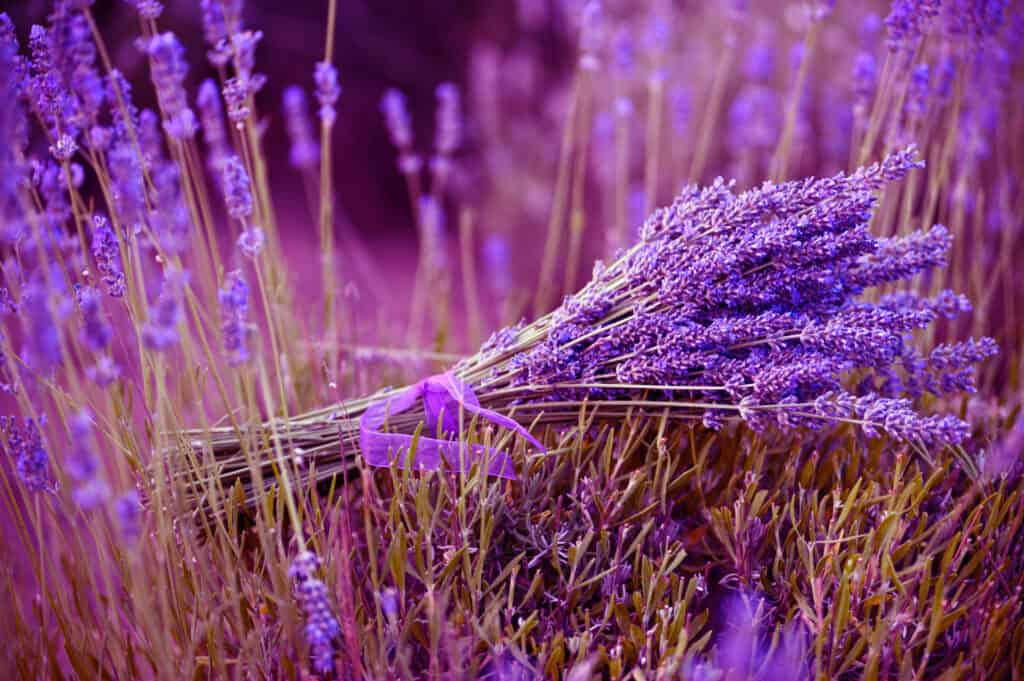Lavender plants are highly scented perennial shrubs with tiny purple, indigo, or pink-white flowers. And there is nothing quite like the sight and smell of a field of lavender in full bloom! So when does lavender bloom where you live? To answer that, you must first consider your local USDA Hardiness Zones and the types of lavender plants you grow.

English lavender blooms in mid to late summer in Zones 5-9.
©gardendata/ via Getty Images
Peak Lavender Season By Zone
Lavender typically grows best in Zones 5–9, but providing some extra TLC can help it thrive in additional climates. However, the peak season for lavender blooms can differ by Hardiness Zone.
The USDA Plant Hardiness Zone Map is a resource for determining a plant’s ability to thrive in a specific U.S. location. The map’s Zones are based on the average minimum winter temperatures in each. For example, the average minimum winter temps in Zone 3a tend to be 10–20 degrees colder than the average lowest winter temps in Zone 9a.
Lavender Bloom Timing
See below for lavender’s peak season by Zone. Keep in mind that these are general bloom times that can vary by plant variety or cultivar. Also, note that new lavender plants grown from seedlings may need two years to establish before they start producing blooms.
| USDA Hardiness Zones | Peak Season for Lavender Blooms |
|---|---|
| Zones 2a-2b | Late summer, depending on the cultivar. Though difficult, you might succeed in growing plants in pots as annuals in this colder Zone. Choose cold-hardy English lavender cultivars like ‘Munstead.’ Bring pots inside when the cold weather arrives. |
| Zones 3a-3b | Mid-summer to fall, depending on the cultivar. Cold-hardy English lavender cultivars like ‘Phenomenal’ and ‘Munstead’ might do well as annuals in Zones 3–4. Bring potted lavender inside through the coldest months. |
| Zones 4a-4b | Mid-summer to fall, depending on the cultivar. As with Zone 3, lavender plants in Zone 4 need to be hardy for colder zones. In addition to ‘Phenomenal’ and ‘Munstead,’ you could grow cold-hardy English lavender ‘Hidcote’ and ‘Superblue’ plants. Note that because of the colder climate, your plants might not survive the winter. Bring potted lavender inside through the coldest months. |
| Zones 5a-5b | Mid-spring to late summer, depending on the cultivar |
| Zones 6a-6b | Mid-spring to late summer, depending on the variety and cultivar |
| Zones 7a-7b | Mid-spring to late summer, depending on the cultivar |
| Zones 8a-8b | Mid-spring to late summer, depending on the cultivar |
| Zones 9a-9b | Mid-spring to late summer, depending on the cultivar |
| Zones 10a-10b | Mid-spring to late summer, depending on the cultivar. Spanish lavender is drought-tolerant for hotter climates like Zone 10, as are many lavandin hybrids like ‘Grosso.’ French lavender is another good choice here. |
| Zones 11a-11b | Mid-spring to late summer, depending on the cultivar. As with Zone 10, French and Spanish lavender cultivars tend to do best in hotter climates like Zone 11. And you can’t go wrong with the lavandin hybrids, like ‘Phenomenal.’ |

Spanish or
butterfly
lavender blooms in early to late summer in Zones 8–9.
©gardendata/ via Getty Images
Types of Lavender Plants
Lavender is an aromatic herb that is also part of the mint family. And the type of lavender you grow can affect the timing of the plant’s blooms.
According to the United States Lavender Growers Association, there are currently over 45 different species and 450 varieties of lavender plants. Each has its own unique style and growth habits, including varying timing when they bloom.
When does lavender bloom if you’re growing English lavender vs. French lavender? Or Spanish lavender vs. Portuguese? How about all of the lavandin hybrid plants? Knowing the different peak seasons for these plants will help growers make their gardening plans.
Here are the five main types of lavender, their ideal Hardiness Zones, and the peak seasons when they are in bloom.
| Lavender Type | Ideal for These Hardiness Zones | Peak Seasons for Blooms |
|---|---|---|
| 1. English or Common Lavender (Lavandula angustifolia) | Zones 5-9 | Mid to Late Summer |
| 2. Spanish or Butterfly Lavender (Lavandula stoechas) | Zones 8-9 | Early to Late Summer |
| 3. French or Fringed Lavender (Lavandula dentata) | Zones 9-11 | Early Summer to Early Fall |
| 4. Portuguese or Spike Lavender (Lavandula latifolia) | Zones 5-10 | Midsummer to Early Fall |
| 5. Lavandin Hybrids (Lavandula x intermedia) | Zones 5-9 | Mid to Late Summer |

Lavender plants need 6–8 hours of daily sunshine to produce many blooms.
©ESstock/Shutterstock.com
What affects lavender growth and blooms?
Ideal climate and soil quality are essential to the health of lavender plants and their ability to bloom. For example, lavender grown in environments with high humidity might struggle more than plants grown in dry climates. In addition, lavender plants potted in soil with a low lime content won’t bloom as beautifully as those grown in amended soil.
See below for three of the most common conditions that can affect the growth habit and bloom quality of lavender plants. But don’t worry; these conditions are avoidable with easy steps toward prevention.
Not Enough Sunshine
Lavender plants aren’t happy in the shade, so make sure they get 6–8 hours of direct sun daily. If they don’t get enough sun, they produce fewer blooms. However, if you don’t have a sunny garden spot ideal for lavender, these perennial plants grow well in containers.
The Soil is Too Acidic
The lavender plant won’t thrive in overly acidic soil. It needs soil with an average pH of 6.0 to 7.5. So, test your soil (including purchased potting soil) and amend it with lime if necessary. A good rule of thumb is to add 2–3 ounces of hydrated lime powder per cubic foot of soil when needed.
The type of soil you use is important for lavender plants as well. Avoid planting them in heavy clay soil. Instead, use a sandy loam mix that includes lime.
Too Much Water
If lavender plants could speak, they would probably shout, “Keep us dry!” Unfortunately, lavender plants can quickly develop rotted roots if left in wet soil or high humidity for too long. So provide them with the following essential support for healthy, blooming plants:
- Plant lavender in well-draining soil.
- To mulch, use white rock instead of natural mulch since mulch holds more humidity. Why should you use white rock vs. other rocks? White rock reflects the sunshine, helping keep the plants dryer to prevent root rot.
- Once plants are established, wait until the top of the soil is dry before watering lavender again.

Cut lavender blooms stay fresh in a vase for up to a week.
©freya-photographer/Shutterstock.com
How to Extend Lavender Blooms
Whether growing on a hillside or displayed in a pretty container, lavender plants will bloom longer and more often with great care. Toward that goal, we’ve rounded up some helpful tips for extending the life of your lavender flowers.
For Lavender Plants
Lavender plants generally bloom for 3–4 weeks, from early to mid-summer depending on the cultivar. To ensure that you get the most blooms for the longest time possible, follow these simple steps:
- Sunshine is everything! Lavender plants must get at least 6 hours of direct sunlight per day. If they don’t, your plants will produce fewer blooms and get leggy.
- Prune lavender in the spring (March or April) to increase the number of vibrant summer blooms. Or you can choose to grow a twice-blooming lavender cultivar, like one called ‘Sharon Roberts.’ For the twice-blooming variety, prune the plants in mid-summer so they will fill up with blooms a second time in the same growing season.
- Don’t fertilize! Because you will ensure your lavender plants have amended soil with the right balance of nutrients, you won’t need to fertilize them. In fact, fertilizing lavender on top of its already optimized soil could result in a leggy plant that doesn’t bloom at all. Just give lavender the sandy, loamy soil it prefers for the best flower results. If you do feel that fertilizer is necessary, use a light fertilizer application only in the spring.
For Cut Lavender Flowers
Cut lavender blooms will last a long time and make beautiful dried flowers, too. Your cut flowers in a container with water should stay fresh for up to a week. Then, you can trim the bottom inch of the stems, wrap a bouquet of the lavender stems together with twine or ribbon, and hang the bouquet upside down to dry and enjoy for years to come.
Keep dried lavender out of direct sunlight to preserve its color and aroma for as long as possible.
Enjoy the peak season when lavender blooms!
Lavender’s pastel beauty and soothing scent make the peak season for these blooms a special time of year. As long as you give your plants lots of sunshine, don’t overwater, and provide them with amended soil, they will reward you with a lovely display. Plus, long-lasting lavender blooms could last even longer as dried flowers in your home.
The photo featured at the top of this post is © Fesus Robert/Shutterstock.com
Thank you for reading! Have some feedback for us? Contact the AZ Animals editorial team.






